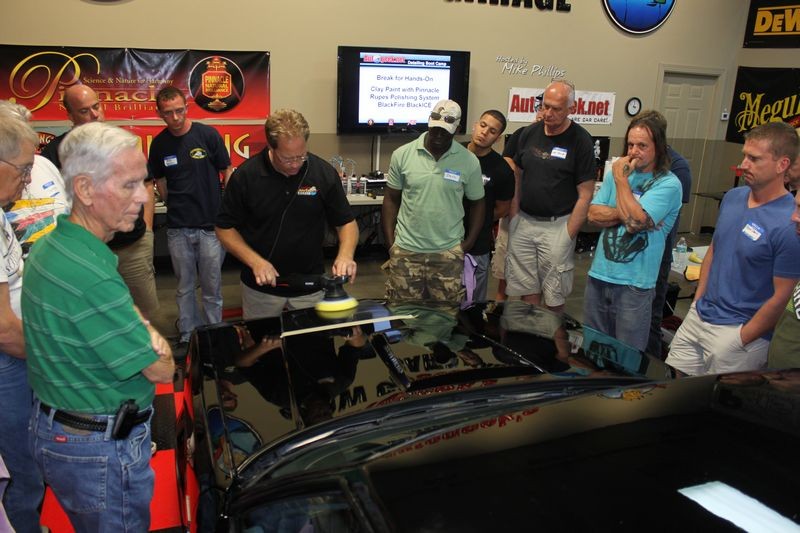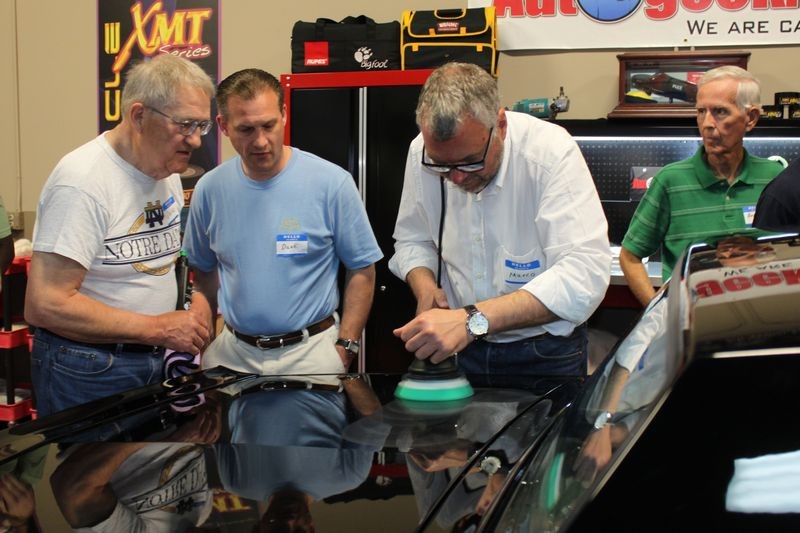Mike - Do you recommend using the slow wipe down method during the compounding, polishing and waxing stage, or just during the polishing stage?
The slow wipe method is only for the FINAL wipe or final passes for removing your LSP.
If you read the article it explains why IN DETAIL as that is my writing style.
The Final Wipe – Tips for creating a streak-free, show car finish
Its funny .. I've watched a bunch of Rupes videos on youtube and it seems like the majority of them are using a fairly quick arm speed,
Marco D'Inca attended one of my Detailing Boot Camp Classes as a guest of honor and he demonstrated how to use his tool and in his demonstration he moved the polisher slowly over the paint.
Here's a thread I made about his visit, and I think it's fair to say he and his colleague enjoyed working on the hotrods and the muscle cars I had here for this class.
VIP Guest Marco D'Inca from Rupes at Autogeek's Detailing Boot Camp Class
Andreas and Marco standing by the 1940 Chevy Sedan Hotrod we buffed out our Detailing Boot Camp Class.
We used this
BLACK 1987 Buick Grand National for the Rupes Training portion of the class,
(I have a dedicated car for each tool and always something cool).
I started the class by doing the Test Spot on the hood as this is always the first thing I teach and practice when buffing out a car I've never worked on before.
And then turned the floor over to Marco to share the official word from the engineer that behind these polishers....
Here's the deal....
When buffing out paint with a dual action polisher you need to move the polisher slowly over the paint when doing HEAVY correction work and even moderate correction work to,
- Give the abrasives time to take bites out of the paint.
- Give the oscillation and rotation of the tool time to work the abrasives against the paint.
- Give the pad and it's part in the abrading function time to work against the paint.
See the reoccurring theme? All of the the above requires
time.
If you move a dual action polisher quickly over the paint this is called
skimming. Sure you can remove defects by skimming over the paint but from my own experience it takes longer.
One of the things I focus all my students on as we work through all the various types of tools on the different cars in my classes is the importance of nailing the correction step and this means moving the polisher slowly over the surface.
You cannot speed the project up and get great results by moving the polisher fast over the paint when using a dual action polisher to remove defects or in other words to remove paint.
Moving the polisher faster might get you to the waxing step faster but after you wipe off the wax you'll find clear, shiny defects still remaining in the paint. At least they'll be shiny.
Also just to interject....
When making a video it takes real concentration to use 100% correct technique, it's easy to make simple mistakes like moving the polisher too fast as you have a lot going on around you.
In the TV world, time is very
COMPRESSED as you only have anywhere from
1 MINUTE to a generous
4-5 MINUTES for the entire segment and one area you can cut down time is to move the polisher a little faster or make less passes as the big picture is to get across the big idea, not get mired down in the minute details that we all have the luxury of time to do on a discussion forum.




